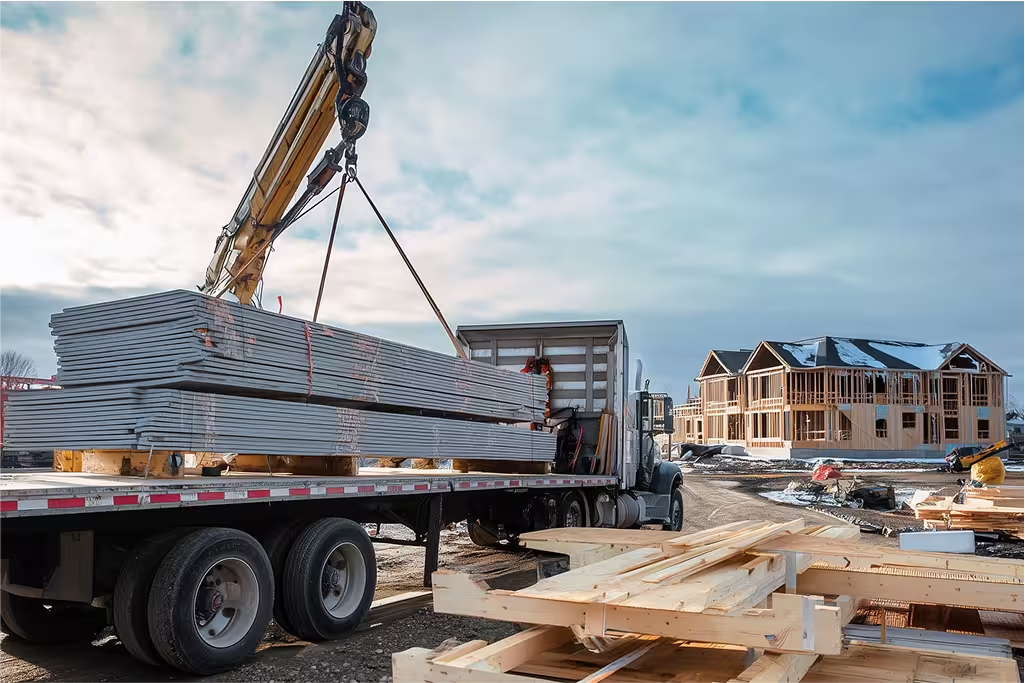Outbuild is online scheduling software to work together on connected project schedules and look-aheads, enabling everyone to move faster.
Key Takeaways
As the old saying goes... you can't push a rope, but you can pull it. If you think about it for a second, it is fairly obvious that pushing a rope will not lead to anything more than a pile of rope in front of you. This reality ultimately leads you to abandon the rope completely and instead push forward whatever you are trying to move.
Now think about attaching that same rope to the object to be moved, collaborating with a team member or two and pulling the object together like in the picture above. Completing the work now requires less individual effort and is more likely to happen by any required completion date.
On construction projects, pushing teams from behind to keep up with the contract schedule often feels similar to pushing a rope. But there is more to the story than that, as construction projects are very complex operations.
Like anything complex, the best way to understand how something is to be built is to reverse-engineer it down to the basic components and follow the trail backwards to where you are today. When you break down a schedule backwards from the target milestone or completion date to where you stand now, gathering input from the front-line workers installing work, you are engaging in construction Pull Planning.
Pull Planning construction project management is a methodology that helps teams optimize their processes and make better use of resources. Often referred to as a part of lean construction management, Pull Planning encourages collaboration between project stakeholders in an effort to continuously improve the communication of important schedule information, reduce waste and avoid delays.
In this article, we will explore what Pull Planning is, how it differs from Push Planning, how to run a Pull Planning session and how Outbuild makes Pull Planning possible on your projects.
Table of Contents
- Tell me more about Pull Planning
- What is Push Planning?
- Benefits of Pull Planning over Push Planning
- What are the steps of running a Pull Planning Session?
- Optimize your construction process with Outbuild's intuitive Pull Planning software
- Conclusion

Pull Planning construction projects involve setting up project plans, including the sequence of activities and tasks that need to be completed in order to reach the desired outcome.
This type of planning requires collaboration between different teams working on a project and encourages everyone involved to work together. It also helps ensure that the team is taking into account any potential obstacles and delays that may arise.
Traditionally, Pull Planning construction sites have white boards and sticky notes to show tasks assigned to various teams. Today construction planning software like Outbuild allows teams to take their construction Pull Planning efforts online, where teams can access the information easier.
How much can the Pull Planning process reduce construction project costs over traditional Push Planning?
Some studies have shown that Pull Planning construction can reduce project costs by up to 15% compared to traditional Push Planning.
This reduction is due to the increased collaboration and efficiency that comes with using Pull Planning. With more efficient processes, teams are better able to identify potential problems early on, allowing them to take corrective action before any major impacts occur.
This helps to reduce costs by eliminating the need for costly rework or additional planning meetings.
How much can Pull Planning reduce construction duration compared to Push Planning?
Other research has found that Pull Planning can reduce construction duration by up to 10% compared to traditional Push Planning. This is also due to the collaborative process and improved efficiency that comes with using Pull Planning and often committing to weekly work plans.
Does Pull Planning impact safety at all?
Pull Planning also has a positive impact on safety on the construction project site. By having all stakeholders actively engaged in the process, teams are able to identify potential hazards earlier.
This allows them to take corrective action before any major impacts occur, reducing the risk of accidents and injuries on the job site. Construction phase plans are also easier to manage with more active communication among stakeholders using this planner system.

More commonly referred to as Critical Path Method (CPM) scheduling, Push Planning is the more traditional planning method used in construction today and still used on the majority of project sites.
This method of planning involves teams making their plans based on what they believe the project timeline should be, identifying critical activities and milestones that can’t be missed, and sticking to the schedule as closely as possible throughout the life of the project.
This type of planning often results in missed deadlines and overruns due to unexpected delays that are not communicated fast enough.
How Pull Planning and the Critical Path are related
The Critical Path is a series of tasks in a project plan that must be completed in order for the project to be successful. Pull Planning construction takes into account any tasks on the critical path and ensures that they are given priority, so that the team can complete them as quickly as possible. This helps minimize delays and ensure that the project is completed within budget.
Pull Planning has several advantages over Push Planning, which involves setting a plan and trying to stick to it no matter what happens.
Pull Panning construction allows for more flexibility as tasks are completed along the way, ensuring that the team can react to any changes quickly.
This type of planning also encourages collaboration with different teams and stakeholders, which can help ensure that everyone is on the same page when it comes to completing the project.
Running a construction pull planning session is a multi-step process that involves the team coming together to assess the project and create a plan.
First, the team needs to identify what tasks are needed to complete the project and create an initial timeline for them.
Then, they need to review any potential issues or risks that may arise due to certain tasks, and come up with solutions for them.
Finally, the team needs to finalize their plans by setting target dates for each task and assigning responsibility for them.
Here’s a quick breakdown of the step-by-step Pull Planning process:
- Identify tasks and create an initial timeline
- Set target dates for each task and assign responsibility
- Review potential roadblocks/issues and come up with solutions
- Monitor progress of the project throughout its duration
- Analyze results, successes, and areas needing improvement
Outbuild is an online construction Pull Planning software, connected directly to project scheduling software, and helps teams optimize their processes and stay ahead of schedule. By utilizing Outbuild, construction teams can reap numerous benefits in executing a construction Pull Plan effectively.
The software allows users to create detailed Lookahead plans directly from the Master Schedule, assign tasks and responsibilities to specific trade partners, keep track of progress, and collaborate with other stakeholders in real time.
This makes it easier for teams to quickly identify potential problems or delays, and communicate these potential problems to those managing the contract schedule automatically.
Without any further introduction, let's dive into the 5 steps mentioned earlier for the Pull Planning construction process, utilizing Outbuild.
Step 1: Identifying tasks and creating an initial timeline
Outbuild simplifies the task identification process by providing a centralized platform to determine the project's logic, flow, and task durations. It allows users to break down activities into individual tasks, ensuring a thorough and comprehensive approach. By collaborating with trade partners and granting them access to Outbuild, the time-consuming task identification process can be completed prior to the Pull Planning session. This enables teams to focus on sequencing and identifying potential roadblocks during the planning phase, saving valuable time.
Key:
- Outbuild allows for easy development of an initial timeline and the breakdown of activities into individual tasks.
- Collaboration with trade partners through Outbuild ensures that tasks are identified in advance, minimizing wasted time during Pull Planning sessions.

Step 2: Setting target dates for each task and assigning responsibility
Outbuild facilitates the automatic assignment of responsibilities to trade partners based on their involvement in the Lookahead. By associating tasks with specific companies and highlighting them with distinct colors, Outbuild ensures clarity and accountability. Additionally, when multiple crews from the same trade are involved, it becomes crucial to assign responsible parties to avoid confusion. Outbuild allows for easy identification of foremen, supervisors, or superintendents, ensuring efficient coordination among teams.
Key:
- Responsibilities are automatically assigned based on the involvement of trade partners, streamlining the process.
- Clear identification of responsible parties within the system prevents confusion and facilitates efficient coordination between multiple crews.

Step 3: Reviewing potential roadblocks and coming up with solutions
Identifying roadblocks is a critical aspect of successful Pull Planning. Outbuild simplifies this process by enabling users to assign roadblocks to specific tasks. By doing so, teams can address issues promptly and ensure seamless progress. Through Outbuild's roadblock tab, users can track and manage roadblocks effectively, removing obstacles and minimizing delays. This proactive approach enhances collaboration and enables the team to address potential challenges before they impact the project schedule.
Key:
- Outbuild simplifies the identification and assignment of roadblocks to specific tasks, allowing for prompt resolution.
- Roadblocks can be effectively managed and tracked, ensuring that potential issues are addressed in a timely manner.

Step 4: Monitoring progress of the project throughout its duration
Tracking project progress is essential for a successful Pull Plan. Outbuild provides a comprehensive solution for updating and monitoring progress at both the overall activity and individual task levels. Real-time field updates feed directly into Outbuild, allowing for accurate progress reporting. This information is seamlessly integrated into the Master Schedule, ensuring that all stakeholders are informed about the project's status.
Key:
- Outbuild enables progress tracking at both the overall activity level and individual task level, providing real-time updates from the field.
- The integration of progress information into the Master Schedule ensures accurate project monitoring.

Step 5: Analyzing results, successes, and areas needing improvement
Outbuild empowers users to analyze project results and identify areas of success and improvement. By comparing progress against baselines and utilizing Outbuild's analytics module, teams gain valuable insights from their experiences. This data-driven approach enhances decision-making, facilitates knowledge sharing, and enables continuous improvement. Outbuild's analytics module provides visual representations, such as pie chart of Reason for Variance or Roadblock Tab Analysis for example, which offer a clear understanding of project challenges and successes.
Key:
- Outbuild offers various analytical tools to track progress against baselines and identify areas for improvement.
- The system's roadblock tracking capabilities and analytics provide valuable insights into project challenges and successes, facilitating informed decision-making.

Pull Planning software like Outbuild revolutionizes the construction Pull Planning process by providing a web-based platform that streamlines task identification, responsibility assignment, roadblock management, progress monitoring, and result analysis. By leveraging Outbuild's collaborative features, construction teams can stay ahead of the competition, can save time, enhance coordination, and optimize their project execution.
We hope this article has given you a better understanding of the importance of Pull Planning and how Outbuild can help you stay ahead.
Frequently Asked Questions
Related Articles
Ready to see Outbuild?
Join hundreds of contractors from 10+ countries that are saving money by scheduling better








